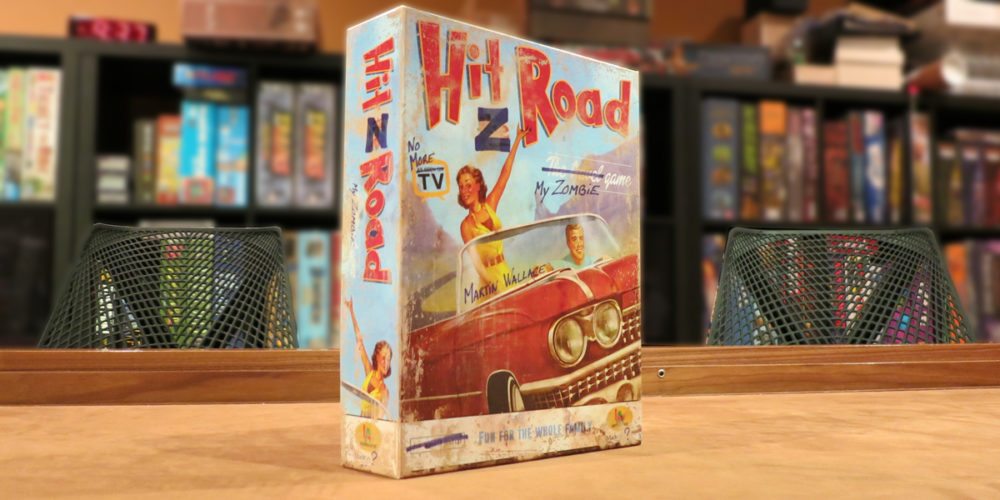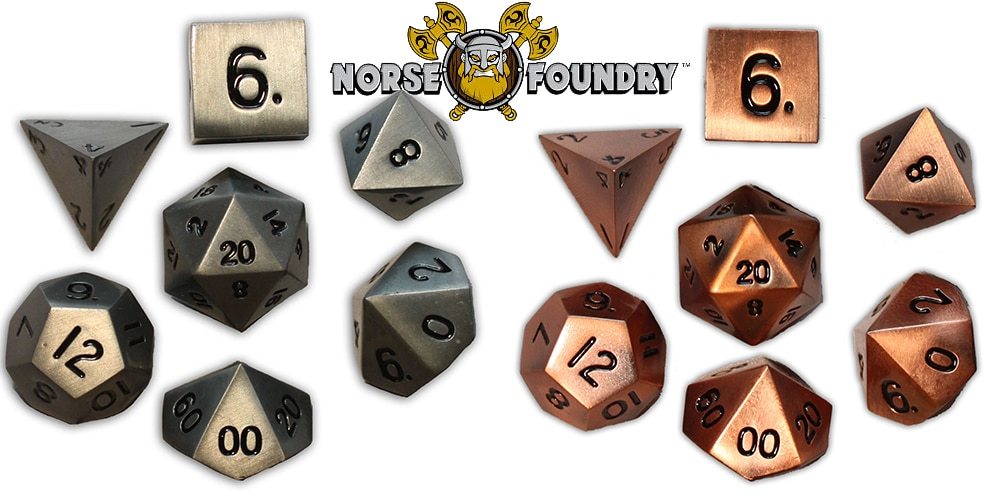1939. You are a German U-Boat commander, at the start of World War II. You get a return on your sonar…is it a whale? Or that enemy destroyer you’ve been hunting? Your crew loads the torpedoes in the launch tubes as you draw closer…
What Is Type 7?
Type 7 is a strategy campaign solitaire game, that can also be played cooperatively with two players. It’s for ages 14+, and playtime is variable depending on the campaign mission. You play as the commander of a Type 7 U-boat during World War 2.
It is designed by engineer and game designer Markus Geiger. Type 7 is currently seeking funding on Kickstarter, with a base gameplay pledge of €99 (approximately $116 at the time of this writing), which includes the rules and a 2 foot-long wooden U-boat model. There are several other pledge levels available, notably a deluxe version for €159 which also comes with a token storage box, as well as a “showcase” model with a detailed interior to the U-boat(which comes in addition to the standard gameplay model, not as a replacement.)
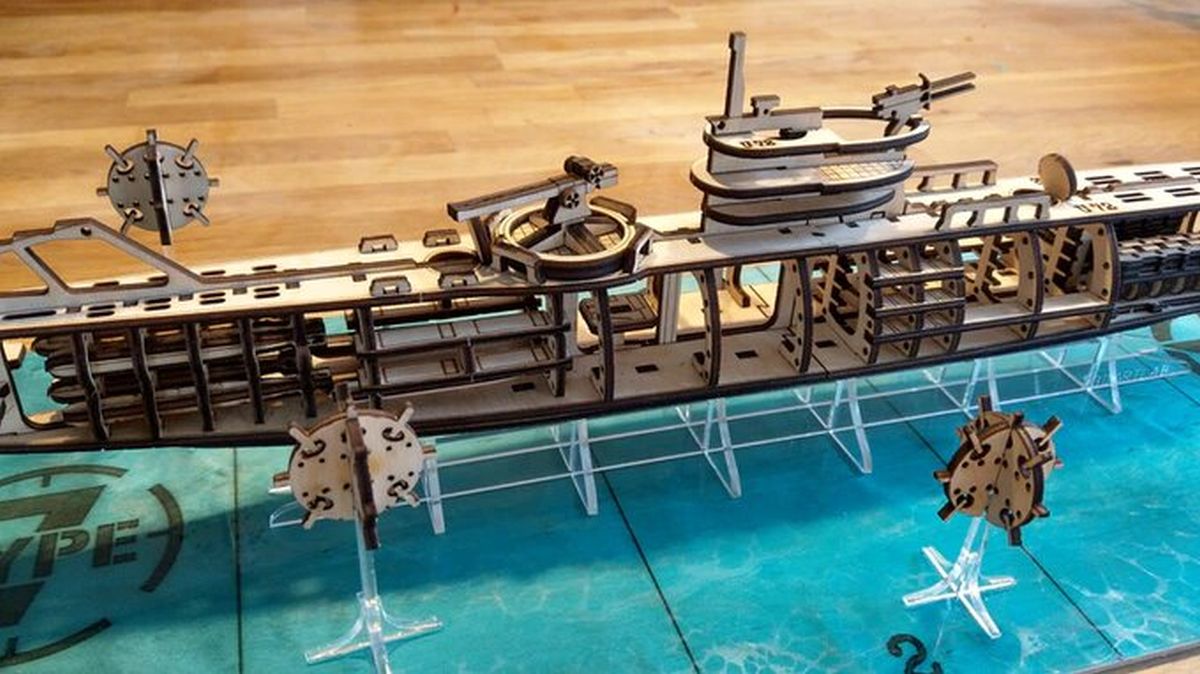
Type 7 is both a tabletop game and a wooden hobby modeling kit; expect to be doing a fair amount of assembling before you can play the game.
New to Kickstarter? Check out our crowdfunding primer>.
Type 7 Components
Note: My review is based on a prototype copy of the game, so it is subject to change and may not reflect final component quality.
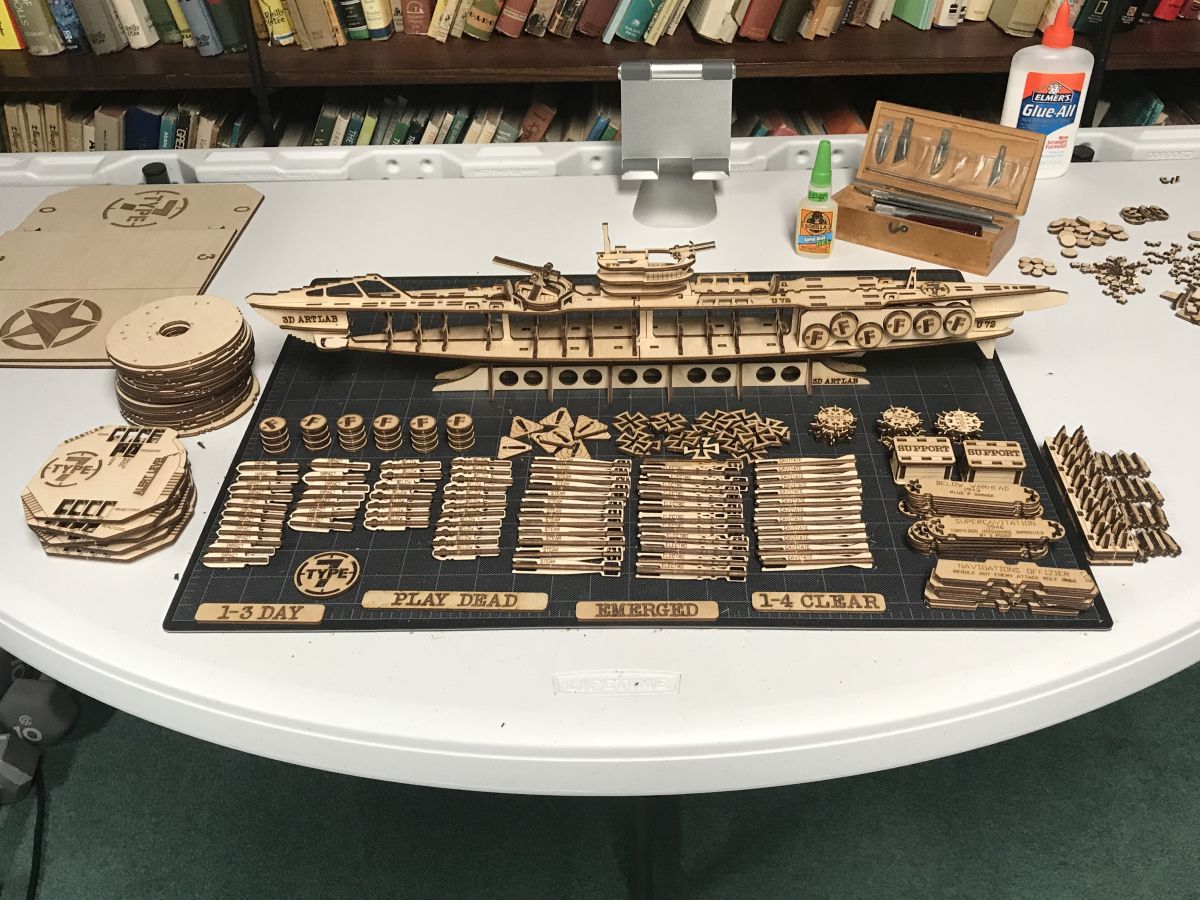
The standard edition contains:
- 1 in game U-boat Type VII length 63 cm
- 1 assembly instructions
- 1 damage token bag
- 1 target disc center tool (used for first assembly)
- 1 game board separated into 2 pieces, containing 5 range zones (0 – 4)
- 1 magazine for 20 deck gun shells
- 1 mission book
- 1 quick reference sheet
- 1 rulebook
- 1 second player token
- 1 string for rigging
- 2 support ticket boxes
- 4 blue dice for probes
- 4 status tokens, double sided with round edges
- 6 red dices for target damage counting
- 6 target disc holders
- 7 crew tokens double sided
- 8 crew panic tokens
- 12 fuel barrels
- 12 torpedo bodies – cavitation
- 12 torpedo bodies – electric
- 12 torpedo bodies – steam
- 13 tech tokens
- 15 victory points
- 16 damage tokens with different effects (shaped like sea mines)
- 18 torpedo warheads – below
- 18 torpedo warheads – standard
- 20 deck gun shells – high explosive
- 20 deck gun shells – armor piercing
- 20 target discs for 10 kinds of enemies (wooden discs)
- 68 target disc slider pins (3 parts per slider)
As I mentioned earlier, this is not only a game but a hobby kit…some assembly is required! Here’s how it looked when I first opened the box for the prototype:

Inside that plastic wrap were several sheets of laser-cut wood. Other than the 2-piece game board, everything needs to be punched out prior to assembly. Here’s a look at the various wood sheets that come with the game:
I started by assembling the U-boat model. After carefully punching out all the pieces, here are the parts that will become the submarine:

And here’s the U-boat, partway through assembly:

There’s some brilliant physical design work at play by Markus Geiger on the components and U-boat model design. 99% of the kit can be assembled simply by push fitting the pieces together. Other than some small ammo drums that you can optionally glue onto the deck guns (using wood glue or Elmer’s glue), the only parts that require glue are small hubs that are attached at the backs of the Target Disc Holders:

Sliders are inserted into the rectangular holes in the Target Disc Holder as the final assembly for those components:

The sliders were a tight fit, but when a Target Disc is attached to the back of the holder, the sliders move well. Everything punched out easily with no damage, except for a couple of pieces of the deck gun ammo, where the wood hadn’t been cut completely through.
How to Play Type 7
You can download a copy of the rules here.
The Goal
Survive a series of campaign missions that take you from the start of WWII in 1939 through an alternate history continuation of the war in 1946.
Setup

Place the game board and U-boat model at the center of the table. Consult the “setup” section in the mission guide for the briefing on the mission you are playing, and place the required components on or near the U-boat (torpedoes and fuel are physically placed onto the model).

Torpedoes in missions can have different bodies and warheads; choose which you want to equip based upon what is allowed for the mission, and combine the warheads with the torpedoes. Similarly, choose which deck gun shells you would like.

Place all damage tokens inside of the draw bag, and place to the side.
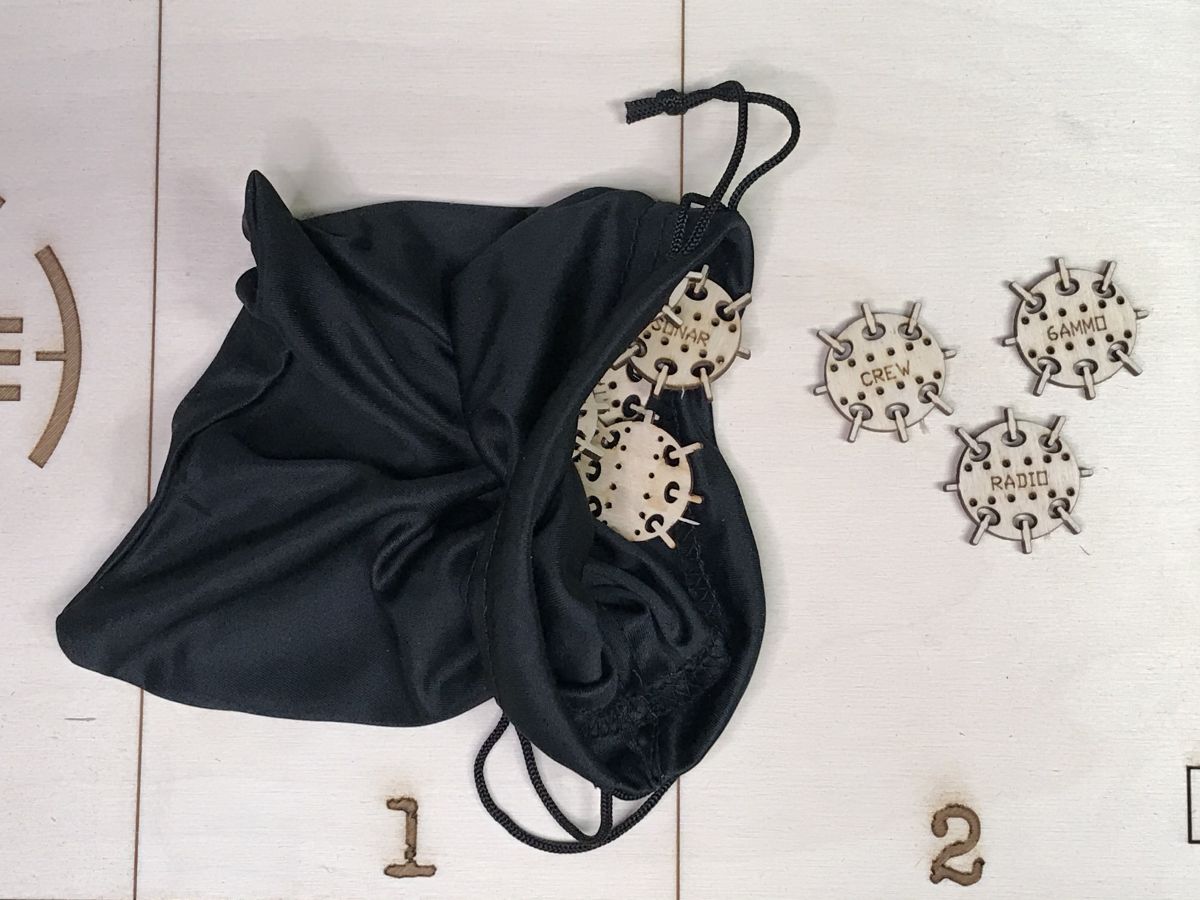
Make stacks of the target disc holders and target discs and place them off to the side. Make stacks of all the tokens and also leave the off to the side, in easy reach along with your dice.
Gameplay
This is a solitaire game, so you will be playing against the game itself rather than a physical opponent. For a great overview of how the game is played, you can watch the video below:
As Type 7 is a wargame simulation, the rules are quite a bit heavier than, say, a game of Risk. I will just be giving you a basic overview of how the game is played; for more in-depth rules, I suggest watching the tutorial video and reading the rulebook.
Each mission briefing will describe your goals, as well as when and how you will earn victory points and upgrades. There will also be an “overworld,” which is an illustration showing a series of zones for that particular mission. You always start in the Shipyard. It costs one fuel to move from one adjacent zone to the next, and you can move in any direction. Most missions also end in a Shipyard, though it doesn’t have to be the same one you started at.

When you move to a new zone, you will roll a die and consult the following chart to see if you will be having an encounter, and, if so, what that encounter may entail. If you are in a friendly zone, you may use a Support Ticket (if you have any) to restock weapons and fuel, and remove a damage token.

If there is an encounter, you will take the types and numbers of Target Discs indicated, shuffle them, and then randomly draw the number of targets indicated. You then attach them to the Target Disc Holder, taking care to not see which discs you have attached, and put the leftover Target Discs aside without looking at them. This gives you a “fog of war,” where you are unsure of what exactly is out there until you have revealed it.
As an example, if you had rolled a 4+ on a Cargo zone, you would take a Ghost, two Cargo, a Tanker, and a Destroyer, and blindly choose three of those. Note: you may avoid an encounter by spending 1 fuel.
Next you roll for time and weather conditions, which will affect combat. Rotate the corresponding tokens accordingly. If the conditions are unfavorable, you can choose to delay the encounter and reroll, but it may result in loss of fuel.
As the last step before starting a combat encounter, you will roll a die to place each target in a zone. A “1” places a target at distance zone 2, a 2-5 at distance zone 3, and a 6 at distance zone 4.

The Combat Phase
The combat encounters in Type 7 are the meat of the game, and there are a lot of variables that come into play. From the type of enemy, to their alert level and distance, to the type of weaponry used…all of these will affect the encounter. Combat is done in a “Loop,” where you will go through all the different steps of combat until: the enemies are destroyed or have fled, you leave the combat, or your U-boat has been sunk.
Here is just a summation of some of the actions you can take during the combat phase:
Player actions
- Surface or dive. You must be surfaced to move 2 zones in a turn.
- Move. You may move either towards or away from the target(s); when you move, instead of moving yourself, you will move the targets either closer to or farther away from zone 0.
- Sight targets. Make a roll to see if you can determine what the target is. If you are successful, you will move the corresponding slider on the Target Disc Holder up, revealing what it is.
- Load or unload torpedo launchers.
- Attack. You can fire up to 4 torpedoes. If you are surfaced, you can also fire your deck cannon and FLAK. Different types of torpedoes/warheads/deck gun shells will do different damage and have different effects.
- Deep dive if submerged.
- Maneuver. Spend one fuel to move an enemy target up to two zones.

Enemy Alerts
Targets have three different alert levels, represented by three different notches along the Target Discs. When an alert level changes, rotate the Target Disc to the appropriate alert level; how a target behaves at each alert level will change depending on the particular target.
- If damaged: a target will increase to alert level 3 unless damaged by electric torpedoes, which instead will increase the alert level by one.
- If attacked: alert level may increase depending on the target and what weapon was used in the attack.
- Sight test: targets will roll to see if they can spot you, which will increase their alert level.
- Radio test: using your radio may cause the target to increase its alert level.
- Group alert: If a single target increased its alert level, it may cause other targets to also increase their levels.
Enemy Reactions
Depending on the zone that they are in and the alert level, there are several different reactions an enemy can take. Move the slider up for the zone the enemy is in to reveal the reaction symbol.
- Move towards or away from your U-boat
- Initiate an active sonar scan
- Attack
When you as the player take damage, you draw a damage token out of the bag and also increase your crew’s panic level by 1. If the crew’s panic level gets high enough, it can make it more difficult to fire weapons and might make it so that you can’t use crew skills. Each turn you can attempt to reduce the crew’s panic level, but there’s also a small risk you can make it worse.

Damage to your U-boat can have devastating effects on your ship’s systems. And if you ever take 10 damage, you lose the mission.

End of Combat Loop
There are just a few more things that happen before you go back to the start of the loop.
- Deep dive. If you initiated a deep dive, you must roll to see if you took damage. If you’re playing dead or performing a deep dive, you can roll to see if you’ve lowered the enemy’s alert level.
- Enemy support roll. Enemy targets at alert level 3 can roll to see if they bring in any ships or planes to assist them.
- Weather change: On a roll of 6, switch the Weather token to its other side.
Once a combat has finished, all crew panic is removed and you may reload your torpedoes. Receive victory points for vanquished targets according to the mission briefing.
Mission End
Once you have completed the mission, you will gain 1 additional victory point if you have taken 3 damage points or less; or lose one victory point if you have 6 or more damage points.
You can then spend victory points to either upgrade crew members or develop new technologies (technologies are limited by the year in which you are playing the mission) in preparation for the next mission.

Type 7: The Verdict
I’m not generally what one would call a solo boardgamer. For me, playing games on a tabletop is a communal activity, meant to be shared with friends and family. But we’re also in the midst of a global pandemic, and getting together with friends to play in person is an activity which brings no small amount of risk. So of late I’ve been wondering: can I enjoy a solo gaming experience?
With Type 7, the answer is a definitive “yes.”
Type 7 provides a very satisfying strategic experience, helped in no small part by Geiger’s innovative Target Disc system. It successfully emulates the “fog of war”: Encounters become tense engagements as you’re never quite sure what a target might be until you’ve identified it. It could turn out to be nothing at all…or a deadly battleship. And the enemy will be trying to identify you, as well! You might start out an encounter confident in your success, only to come under heavy fire and have to play dead in the hopes that your foe will lose interest in you and go away. The Target Disc system allows for enemy behavior to change as they come under fire or identify your U-boat, making those combat encounters dynamic.
Let’s be clear though: Type 7 is not a casual game. It is a simulation of submarine warfare, so there are a lot of variables to take into account among the many actions you can take. Some of those options are also restricted to the particular year of the campaign; yet another variable to take into consideration. That being said, the game is not particularly difficult to learn. The rules are clearly laid out, and having a tutorial video really helps to get an idea for the flow of action when playing a mission. Just be prepared to frequently reference the rulebook, especially during your first few games.
One of the things that really drew my attention initially to Type 7 were the wooden components. Being a longtime hobby modelist, I appreciated the work that had gone into designing the U-boat model and all of the accompanying game pieces. And assembling that model was a joy. All the pieces fit together nicely, and the end result speaks for itself.

Some of you may have read through my review, and decided that Type 7 isn’t the game for you…but you still can’t help admiring that U-boat model. If that’s the case, then you’ll be happy to hear that there’s also a pledge level that allows you to pick up just the Showcase U-Boat model by itself, for €39.
But if you love Das Boot, The Hunt for Red October or U-571, then this might be the game for you. You’ll find hours of enjoyment as you hunt the oceans for your foes, your crew gaining experience and abilities with each mission you complete. To find out more about Type 7 or to make a pledge, head on over to the Kickstarter campaign page.
![]() To subscribe to GeekDad’s tabletop gaming coverage, please copy this link and add it to your RSS reader.
To subscribe to GeekDad’s tabletop gaming coverage, please copy this link and add it to your RSS reader.
Click here to see all our tabletop game reviews.
Disclosure: GeekDad received a copy of this game for review purposes.




